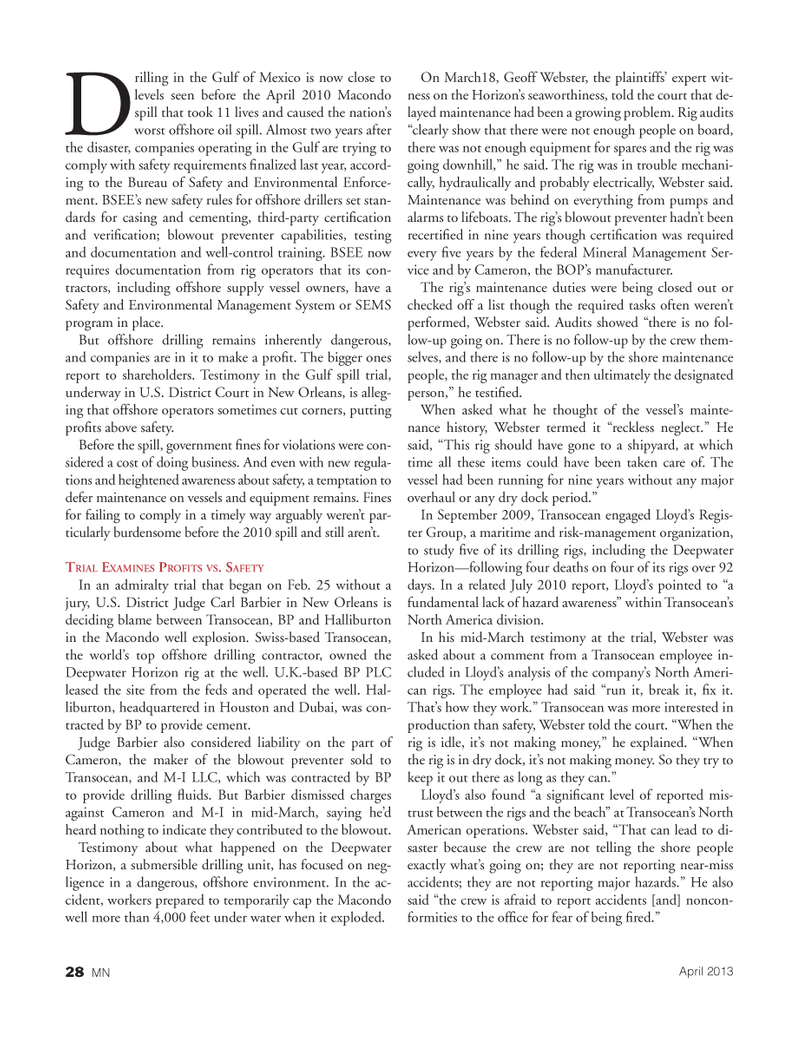
Page 28: of Marine News Magazine (April 2013)
Offshore Service Operators
Read this page in Pdf, Flash or Html5 edition of April 2013 Marine News Magazine
Drilling in the Gulf of Mexico is now close to levels seen before the April 2010 Macondo spill that took 11 lives and caused the nation?s worst offshore oil spill. Almost two years after the disaster, companies operating in the Gulf are trying to comply with safety requirements nalized last year, accord- ing to the Bureau of Safety and Environmental Enforce- ment. BSEE?s new safety rules for offshore drillers set stan- dards for casing and cementing, third-party certi cation and veri cation; blowout preventer capabilities, testing and documentation and well-control training. BSEE now requires documentation from rig operators that its con- tractors, including offshore supply vessel owners, have a Safety and Environmental Management System or SEMS program in place. But offshore drilling remains inherently dangerous, and companies are in it to make a pro t. The bigger ones report to shareholders. Testimony in the Gulf spill trial, underway in U.S. District Court in New Orleans, is alleg- ing that offshore operators sometimes cut corners, putting pro ts above safety. Before the spill, government nes for violations were con- sidered a cost of doing business. And even with new regula- tions and heightened awareness about safety, a temptation to defer maintenance on vessels and equipment remains. Fines for failing to comply in a timely way arguably weren?t par- ticularly burdensome before the 2010 spill and still aren?t. TRIAL EXAMINES PROFITS VS. SAFETY In an admiralty trial that began on Feb. 25 without a jury, U.S. District Judge Carl Barbier in New Orleans is deciding blame between Transocean, BP and Halliburton in the Macondo well explosion. Swiss-based Transocean, the world?s top offshore drilling contractor, owned the Deepwater Horizon rig at the well. U.K.-based BP PLC leased the site from the feds and operated the well. Hal- liburton, headquartered in Houston and Dubai, was con- tracted by BP to provide cement. Judge Barbier also considered liability on the part of Cameron, the maker of the blowout preventer sold to Transocean, and M-I LLC, which was contracted by BP to provide drilling uids. But Barbier dismissed charges against Cameron and M-I in mid-March, saying he?d heard nothing to indicate they contributed to the blowout. Testimony about what happened on the Deepwater Horizon, a submersible drilling unit, has focused on neg- ligence in a dangerous, offshore environment. In the ac- cident, workers prepared to temporarily cap the Macondo well more than 4,000 feet under water when it exploded. On March18, Geoff Webster, the plaintiffs? expert wit- ness on the Horizon?s seaworthiness, told the court that de- layed maintenance had been a growing problem. Rig audits ?clearly show that there were not enough people on board, there was not enough equipment for spares and the rig was going downhill,? he said. The rig was in trouble mechani- cally, hydraulically and probably electrically, Webster said. Maintenance was behind on everything from pumps and alarms to lifeboats. The rig?s blowout preventer hadn?t been recerti ed in nine years though certi cation was required every ve years by the federal Mineral Management Ser- vice and by Cameron, the BOP?s manufacturer. The rig?s maintenance duties were being closed out or checked off a list though the required tasks often weren?t performed, Webster said. Audits showed ?there is no fol- low-up going on. There is no follow-up by the crew them- selves, and there is no follow-up by the shore maintenance people, the rig manager and then ultimately the designated person,? he testi ed.When asked what he thought of the vessel?s mainte- nance history, Webster termed it ?reckless neglect.? He said, ?This rig should have gone to a shipyard, at which time all these items could have been taken care of. The vessel had been running for nine years without any major overhaul or any dry dock period.? In September 2009, Transocean engaged Lloyd?s Regis- ter Group, a maritime and risk-management organization, to study ve of its drilling rigs, including the Deepwater Horizon?following four deaths on four of its rigs over 92 days. In a related July 2010 report, Lloyd?s pointed to ?a fundamental lack of hazard awareness? within Transocean?s North America division. In his mid-March testimony at the trial, Webster was asked about a comment from a Transocean employee in- cluded in Lloyd?s analysis of the company?s North Ameri- can rigs. The employee had said ?run it, break it, x it. That?s how they work.? Transocean was more interested in production than safety, Webster told the court. ?When the rig is idle, it?s not making money,? he explained. ?When the rig is in dry dock, it?s not making money. So they try to keep it out there as long as they can.? Lloyd?s also found ?a signi cant level of reported mis- trust between the rigs and the beach? at Transocean?s North American operations. Webster said, ?That can lead to di- saster because the crew are not telling the shore people exactly what?s going on; they are not reporting near-miss accidents; they are not reporting major hazards.? He also said ?the crew is afraid to report accidents [and] noncon- formities to the of ce for fear of being red.? April 201328 MNMN April2013 Layout 18-31.indd 28MN April2013 Layout 18-31.indd 284/1/2013 12:00:24 PM4/1/2013 12:00:24 PM

 27
27

 29
29
